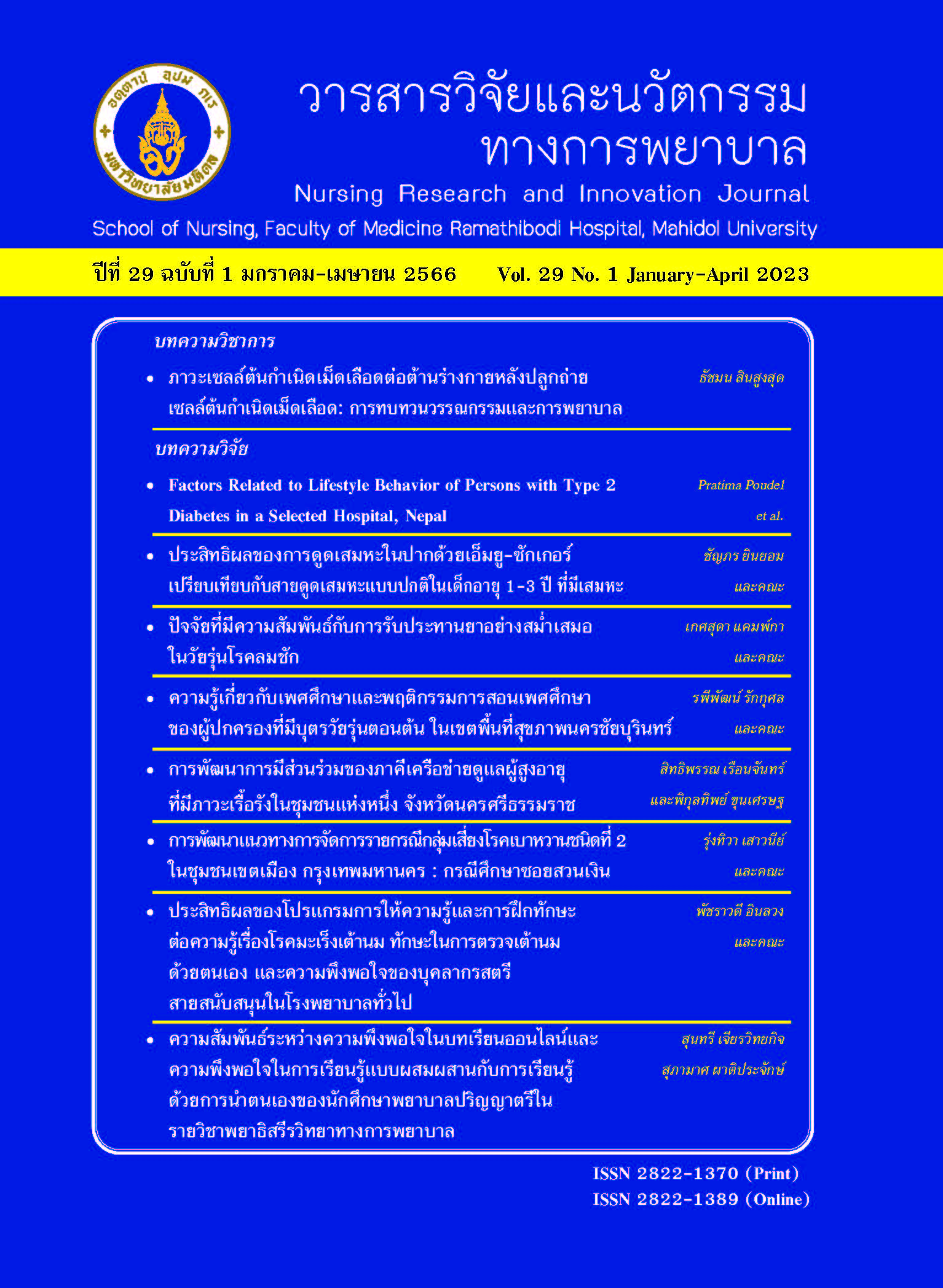ปัจจัยที่มีความสัมพันธ์กับการรับประทานยาอย่างสม่ำเสมอในวัยรุ่นโรคลมชัก
Main Article Content
บทคัดย่อ
การวิจัยเชิงบรรยาย ครั้งนี้ มีวัตถุประสงค์เพื่อศึกษาการรับประทานยาอย่างสม่ำเสมอในวัยรุ่นโรคลมชัก และปัจจัยที่มีความสัมพันธ์กับการรับประทานยาอย่างสม่ำเสมอในวัยรุ่นโรคลมชัก คัดเลือกกลุ่มตัวอย่างแบบเฉพาะเจาะจงตามเกณฑ์ที่กำหนด กลุ่มตัวอย่างเป็นวัยรุ่นโรคลมชักจำนวน 126 ราย เก็บรวบรวมข้อมูลโดยใช้แบบสอบถามข้อมูลพื้นฐานผู้ป่วยวัยรุ่นโรคลมชัก แบบสอบถามวิธีการใช้ยา แบบสอบถามแรงสนับสนุนทางสังคม แบบสอบถามการติดต่อสื่อสารระหว่างบุคลากรสุขภาพกับผู้ป่วย แบบสอบถามอาการไม่พึงประสงค์ของยากันชักแบบสอบถามความรู้เกี่ยวกับโรคลมชัก และแบบสอบถามการรับรู้สมรรถนะแห่งตน พบว่ากลุ่มตัวอย่างร้อยละ 92.90 มีการรับประทานยากันชักอย่างสม่ำเสมอ วิเคราะห์ข้อมููลโดยใช้สถิติสัมประสิทธิ์สหสัมพั นธ์แบบสเปียร์แมน พบว่าแรงสนับสนุุนทางสังคม การสื่อสารระหว่างบุุคลากรสุุขภาพกับผู้ป่วย และการรับรู้สมรรถนะแห่งตน มีความสัมพันธ์ทางบวกกับการรับประทานยาอย่างสม่ำเสมอในกลุ่มตัวอย่างวัยรุ่นโรคลมชักอย่างมีนัยสำคัญทางสถิติ ส่วนอาการไม่พึงประสงค์ของยากันชักและความรู้เกี่ยวกับโรคลมชักไม่มีความสัมพันธ์กับการรับประทานยากันชักอย่างสม่ำเสมอ ข้อเสนอแนะจากการวิจัย คือควรมีการประเมินและส่งเสริมแรงสนับสนุุนทางสังคมให้กับวัยรุ่นโรคลมชัก ส่งเสริมให้มีการสื่ อสารกันมากขึ้นระหว่างบุุคลากรทางสุุขภาพกับผู้ป่วย และควรหาวิธีการเสริมสร้างสมรรถนะแห่งตนของวัยรุ่นโรคลมชักเพื่อทำให้วัยรุ่นโรคลมชักมีการรับประทานยากันชักอย่างสม่ำเสมอมากยิ่งขึ้น
คำสำคัญ : วัยรุ่น โรคลมชัก การรับประทานยาอย่างสม่ำเสมอ
Article Details

อนุญาตภายใต้เงื่อนไข Creative Commons Attribution-NonCommercial-NoDerivatives 4.0 International License.
บทความ ข้อมูล เนื้อหา รูปภาพ ฯลฯ ที่ได้รับการตีพิมพ์ในรามาธิบดีพยาบาลสาร ถือเป็นลิขสิทธิ์ของวารสาร หากบุคคลหรือหน่วยงานใดต้องการนำทั้งหมดหรือส่วนหนึ่งส่วนใดไปเผยแพร่หรือเพื่อกระทำการใด ใด จะต้องได้รับอนุญาตเป็นลายลักษณ์อักษรจากรามาธิบดีพยาบาลสารก่อนเท่านั้น
เอกสารอ้างอิง
World health organization. Epilepsy 2017 [cited 2017 February 20]. Available from: http://www.who.int/ mediacentre/factsheets/fs999/en/
Dalbem JS, Dalbem AS, Siqueira HH, Alvarenga RMP,Andraus MEC. Epilepsy prevalence in children and adolescents aged 0 -19 years-a door-to-door study. J Neurol Sci. 2015;357:196. doi:10.1016/j.jns.2015.08.679.
Farghaly WM, Abd Elhamed MA, Hassan EM, Soliman WT, Yhia MA, Hamdy NA. Prevalence of childhood and adolescence epilepsy in Upper Egypt (desert areas). Egypt J Neurol Psychiatr Neurosurg. 2018;54(1):34.doi:10.1186/s41983-018-0032-0.
Information Division Ramathibodi Hospital. The statistics of children with epilepsy receiving treatment at the pediatric outpatient department, Ramathibodi Hospital; 2559.
Minardi C, Minacapelli R, Valastro P, Vasile F, Pitino S,Pavone P, et al. Epilepsy in children: from diagnosis to treatment with focus on emergency. J Clin Med.2019;8(1):39.doi:10.3390/jcm8010039
Jones RM, Butler JA, Thomas VA, Peveler RC, Prevett M. Adherence to treatment in patients with epilepsy:associations with seizure control and illness beliefs.Seizure. 2006;15(7):504-8. doi:10.1016/j.seizure.2006.06.003.
Moffat C, Dorris L, Connor L, Espie CA. The impact of childhood epilepsy on quality of life: a qualitative investigation using focus group methods to obtain children’s perspectives on living with epilepsy. Epilepsy Behav. 2009;14(1):179-89. doi:10.1016/j.yebeh.
09.025.
Kyngas H. Compliance with health regimens of adolescents with epilepsy. Seizure. 2000;9(8):598-604. doi:10.1053/seiz.2000.0470.
World Health Organization. ( 2003) . Adherence to longterm therapies: evidence for action. World Health Organization. Available from: http://apps.who.int/iris/handle/10665/42682
Malik MA, Shabbir N, Saeed M, Malik H, Mirza A.Medication nonadherence in children with epilepsy attending outpatient under-resourced community. J Pediatric Epilepsy. 2015;4(2):72-9. doi: 10.1055/s-0035-1555600.
Getnet A, Woldeyohannes SM, Bekana L, Mekonen T,Fekadu W, Menberu M, et al. Antiepileptic drug nonadherence and its predictors among people with epilepsy. Behav Neurol. 2016;2016:3189108. doi:10.1155/ 2016/3189108.
Shegaw M, Kassa R, Ali Y, Addissu N. Prevalence and associated factors of antiepileptic drug nonadherence among epileptic patients attending at outpatient department of Dilla University Referral Hospital, Dilla, Gedeo,SNNPR, Southern Ethiopia. Int J of Biosci and Med.
;1(2). doi:10.28933/ijbm-2017-07-1401.
Michie S, Miles J, Weinman J. Patient-centredness in chronic illness: what is it and does it matter?. Patient Educ Couns. 201403;51(3):197-206. doi:10.1016/s0738-3991(02)00194-5.
Pooya A, Akbar A. Drug compliance of children and adolescents with epilepsy. Seizure. 2005;14(6):393-5. doi:10.1016/j.seizure.2005.05.003.
Gabr WM, Shams ME. Adherence to medication among outpatient adolescents with epilepsy. Saudi Pharm J.2014;23(1):33-40. doi:10.1016/j.jsps.2014.05.003
Tan XC, Makmor-Bakry, M., Lau, C. L., Tajarudin, F.W., & Raymond, A. A. Factors affecting adherence to antiepileptic drugs therapy in Malaysia. Neurol Asia.2015;20(3):235-41.
López González FJ, Rodríguez Osorio X, Gil-Nagel Rein A, Carreño Martínez M, Serratosa Fernández J, Villanueva Haba V, et al. Drug-resistant epilepsy: definition and treatment alternatives. Neurología (English Edition).2015;30(7):439-46. doi:10.1016/j.nrl.2014.04.012.
Morita DA, Glauser TA, Modi AC. Development and validation of the Pediatric Epilepsy Side Effects Questionnaire. Neurology. 2012;79(12):1252-8.doi:10.1212/WNL.0b013e3182635b87.
Verma N, Tripathi, S., & Sharma, S. Drug compliance in children with epilepsy: cross-sectional study in New Delhi.Indian J child Health. 2016;3(4):311-3. doi:10.32677/IJCH.2016.v03.i04.010.
Qoul KZ, Qasem, D. A., Samawi, O. H., Matter, L. N.,Abo-tineg, S. I., & Abo-olem, M. Antiepileptic medication adherence in children with epilepsy at Queen Rania Al-Abdullah children hospital. Indian J Med Res Pharm Sci. 2015;2(10):16-23.
Chuaichum C. Factors related to medication adherence in patients with epilepsy [thesis]. Bangkok: Chulalongkorn University; 2012. (in Thai)
Kobau R, DiIorio C. Epilepsy self-management: a comparison of self-efficacy and outcome expectancy for medication adherence and lifestyle behaviors among people with epilepsy. Epilepsy Behav. 2003;4(3):217-25.doi:10.1016/s1525-5050(03)00057-x.
Noosorn N. Social support and health promotion. In:Noosorn N, editor. Health promotion in the community concept and practice. Bangkok: Chulalongkorn University publisher; 2010.
Pinprapapan E, Phanuthai S, Vannarit T, Srisuphan W. A causal model of adherence to therapeutic regimens among persons with hypertension. Pacific Rim Int J Nurs Res.2013;17(3):268-81.
WHO. Technical report No 498. International drug monitoring, the role of national centres, Geneva: The Institute; 1972. Available from: https://who-umc.org/media/2680/who-technical-report-498.pdf
Burns N, Grove SK. The practice of nursing research:conduct, critique and utilization. 5th ed. Missouri: Elsevier Saunders; 2005.
Martin B. Sample size for clinical trials 2011. Available from: https://www-users.york.ac.uk/~mb55/bsi_study/sampsz5.pdf
Horne R. The Medication Adherence Report Scale(MARS). University of Brighton; 1996.
Rungruangsiripan M, Sitthimongkol Y, Maneesriwongul W, Talley S, Vorapongsathorn T. Mediating role of illness representation among social support, therapeutic alliance,experience of medication side effects, and medication adherence in persons with schizophrenia. Arch Psychiatr Nurs. 2011;25:269-83. doi:10.1016/j.apnu.2010.09.002.
Polsook R, Aungsuroch Y, Thanasilp S. Medication adherence among persons with post-acute myocardial infarction. Songklanakarin J Sci Technol. 2016;38:611-20.
Vaglio J Jr, Conard M, Poston WS, O'Keefe J, Haddock CK, House J, Spertus, JA. Testing the performance of the ENRICHD social support instrument in cardiac patients.Health Qual Life Outcomes. 2004;2:24. doi:10.1186/1477-7525-2-24.
Kongsaktrakul C. A causal model of self-care behavior for adolescents with epilepsy [dissertation]. Chiangmai:Chiangmai University; 2006
Risser J, Jacobson TA, Kripalani S. Development and psychometric evaluation of the Self-efficacy for Appropriate Medication Use Scale (SEAMS) in lowliteracy patients with chronic disease. J Nurs Meas.2007;15(3):203-19. doi:10.1891/106137 407783 095757.
Virag L, Murgas M, Kuzelova M. Pharmacotherapeutic adherence and quality of life in paediatric outpatients with epilepsy. Eur Pharm J. 2012;59(Supplement-VI): 76-83. doi:10.2478/v10219-012-0009-5.
Shallcross AJ, Becker DA, Singh A, Friedman D, Jurd R,French JA, et al. Psychosocial factors associated with medication adherence in ethnically and socioeconomically diverse patients with epilepsy. Epilepsy Behav.2015;46:242-5. doi:10.1016/j.yebeh.2015.01.034.
Worrkitkasemkul S. Research methodology for behavior and social science. Udon Thani: Udon Thani Rajabhat University; 2011. (in Thai)
Akbarbegloo M, Valizadeh L, Zamanzadeh V, Jabarzadeh F. The relationship between self-efficacy and psychosocial care in adolescents with epilepsy. Epilepsy Res Treat.2015;2015:756849. doi:10.1155/2015/756849.
Gurumurthy R, Chanda K, Sarma G. An evaluation of factors affecting adherence to antiepileptic drugs in patients with epilepsy: a cross-sectional study. Singapore Med J.2017;58(2):98-102. doi:10.11622/smedj.2016022.
Kangwal C, Kongsaktrakol C, Maneesriwongul W,Visudtibhan A. Factors related to medication adherence among children with epilepsy. Ramathibodi Nursing Journal. 2017;23(1):44-59. (in Thai)
Maiphom S, Leemingsawat W. Heath literacy of caregivers of children with epilepsy. Journal of Sport Science and Health. 2020;21(2):269-82. (in Thai)


